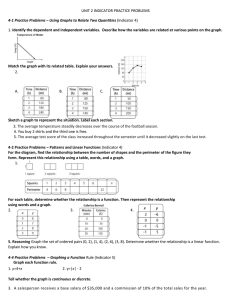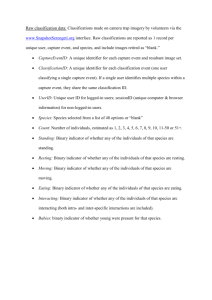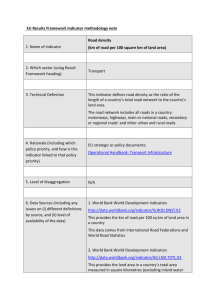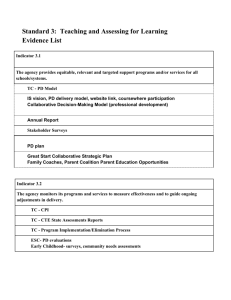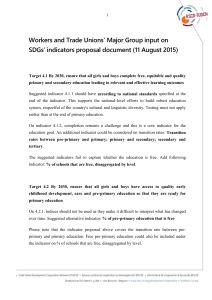Unit 2 Notes KEY 4-1 Notes – Using Graphs to Relate Two
advertisement
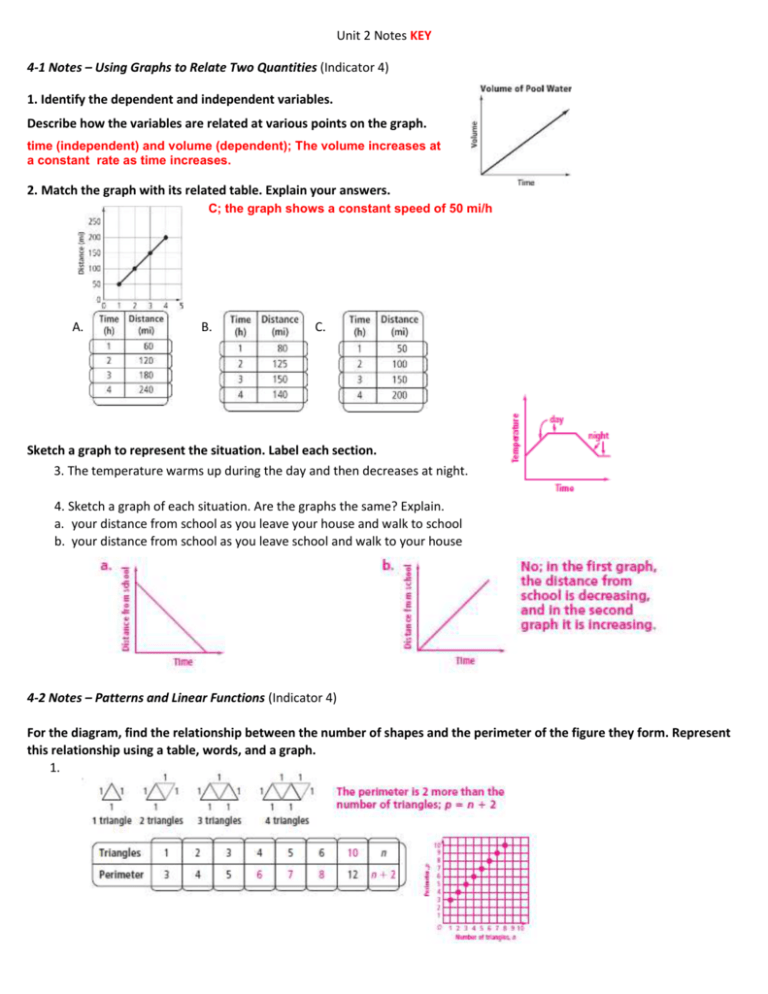
Unit 2 Notes KEY
4-1 Notes – Using Graphs to Relate Two Quantities (Indicator 4)
1. Identify the dependent and independent variables.
Describe how the variables are related at various points on the graph.
time (independent) and volume (dependent); The volume increases at
a constant rate as time increases.
2. Match the graph with its related table. Explain your answers.
C; the graph shows a constant speed of 50 mi/h
A.
B.
C.
Sketch a graph to represent the situation. Label each section.
3. The temperature warms up during the day and then decreases at night.
4. Sketch a graph of each situation. Are the graphs the same? Explain.
a. your distance from school as you leave your house and walk to school
b. your distance from school as you leave school and walk to your house
4-2 Notes – Patterns and Linear Functions (Indicator 4)
For the diagram, find the relationship between the number of shapes and the perimeter of the figure they form. Represent
this relationship using a table, words, and a graph.
1.
For each table, determine whether the relationship is a function. Then represent the relationship using words and a graph.
2.
3.
4.
5. You can make a bubble solution by mixing 1 cup of liquid soap with 4 cups of water. Represent the relationship between the
cups of liquid soap and the cups of bubble solution made using a table, and a graph. Is the amount of bubble solution made a
function of the amount of liquid soap used? Explain. b=5s
4-4 Notes – Graphing a Function Rule (Indicator 5)
Graph each function rule.
1. y = 2–x
2. y = 4x
Tell whether the graph is continuous or discrete.
3. The cost C, in dollars, for a health club membership depends on the number m of whole months you join.
This situation is represented by the function rule C = 49 + 20m. discrete
4. The cost C, in dollars, for bananas depends on the weight w, in pounds, of the bananas. This situation is
represented by the function rule C = 0.5w. continuous
Graph the function rule.
5. y = │x│ +1
4-5 Notes – Writing a Function Rule (Indicator 5)
Write a function rule that represents each sentence.
1. 5 less than one fourth of x is y.
2. The price p of an ice cream is $3.95 plus $0.85 for each topping t on the ice cream.
p = 3.95 + 0.85t
3. A taxicab charges $4.25 for the first mile and $1.50 for each additional mile. Write a rule for describing the
total rate r as a function of the total miles m. What is the taxi rate for 12 miles?
4. Write a function rule for the area of a rectangle whose length is 4 in. more than its width. What is the area
of the rectangle when its width is 8 in.? A = (w+4)w or A=w2+4w, 96 in2
5. Multiple Representations Use the table shown at the right.
a. Graph the ordered pairs on a coordinate plane.
b. Is this a function? Explain. y = 2x + 4
4-6 Notes – Formalizing Relations and Functions (Indicator 6)
Identify the domain and range of the relation. Use a mapping diagram to determine whether the relation is a
function.
1. {(0, 0.4), (1, 0.8), (2, 1.2), (3, 1.6)}
2. Use the vertical line test to determine whether the relation is a function.
A function
1 1 3
f ( x ) x 2 2;{0, , , ,1}
4 2 4
4. Sound travels about 343 meters per second. The function d(t) = 343t gives the distance d(t) in meters that sound travels in t
seconds. How far does sound travel in 8 seconds? 2744 m
3. Find the range of each function for the given domain.
Find a reasonable domain and range for each function. Then graph the function.
5. A charter boat travels at a maximum rate of 25 miles per hour. The function d(x) = 25x represents the distance d(x), in
miles, that the boat can travel in x hours. The charter boat travels a maximum distance of 75 miles from the shore.
4-7 Notes – Arithmetic Sequences (Indicator 7)
Describe the pattern in the sequence. Then find the next two terms of the sequence.
1. 3, 6, 12, 24, … Each term is twice the previous term; 48, 96
Tell whether the sequence is arithmetic. If it is, identify the common difference.
2. 4, 8, 12, 16, … arithmetic; 4
3. You have a gift card for a coffee shop worth $90. Each day you use the card to get a coffee for $4.10. Write a rule to
represent the amount of money left on the card as an arithmetic sequence. What is the value of the card after buying 8
coffees? A(n) = 90 - 4.1n; $57.20
Find the third, fifth, and tenth terms of the sequence described by the rule.
4. A(n) = 4 + (n + 1)(–5) -16, -26, -51
5. Your friend writes A(8) = 3 + (8)(5) as an explicit formula for finding the eighth term of the arithmetic sequence 3, 8,
13, 18, … Describe and correct your friend’s error.
The friend is finding the wrong term; A(n) = 3 + (n - 1)(5) should be the explicit formula, resulting in
A(8) = 3 + (8 - 1)(5) = 38.
4-3 Notes– Patterns and Nonlinear Functions (Indicator 8)
1. Graph the function shown by the table. Tell whether the function is linear or nonlinear.
linear
Identify what type of nonlinear function is pictured below.
2.
3.
4.
Absolute value
quadratic
5.
exponential
cubic
Notes Piecewise and Step Functions (Indicator 8)
1. Determine the requested values using the graph.
f(-2) = 3
f(0) = -1
f(3) = 5
2. Using the given function, determine the value of f(6).
f(6)= -98
Match the graph of the step function with its algebraic representation.
3.
4.
5.
A.
B.
C
C.
B
5-8 Notes Graphing Absolute Value Functions (Indicator 8)
Graph each function by translating y = |x|.
1. y = |x| - 2
2. y = |x| + 4
A
3. y = |x – 5|
Write an equation for each translation of y = |x|.
4. up 7 units
5. left 3 units
y = |x| + 7
y = |x + 3|

